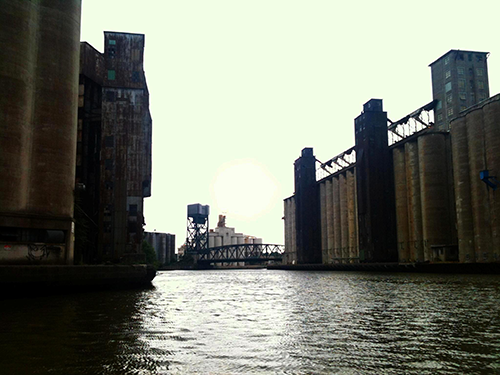Jul 22 2015 Buffalo River Restoration Partnership tackles polluted sediment, moves to improve shoreline and wildlife habitats
 New York’s Buffalo River runs nearly eight miles, serves to drain a 447-square-mile watershed, and — until a recent intersector collaboration turned the tide — was considered one of the Great Lakes’ most polluted bodies of water. Over the past decade, nearly 1 million cubic yards of heavily polluted sediment has been removed from the river, designated in 1987 as a Great Lakes Area of Concern because of poor water quality, contaminated sediment, hazardous waste sites, combined sewer overflows, and degraded fish and wildlife habitat. During the cleanup, EPA Project Director Mary Beth Giancarlo told Buffalo reporters, “We are finding a lot of tires, shopping carts, some bowling balls, and most recently we have pulled up four cars from the same location.”
New York’s Buffalo River runs nearly eight miles, serves to drain a 447-square-mile watershed, and — until a recent intersector collaboration turned the tide — was considered one of the Great Lakes’ most polluted bodies of water. Over the past decade, nearly 1 million cubic yards of heavily polluted sediment has been removed from the river, designated in 1987 as a Great Lakes Area of Concern because of poor water quality, contaminated sediment, hazardous waste sites, combined sewer overflows, and degraded fish and wildlife habitat. During the cleanup, EPA Project Director Mary Beth Giancarlo told Buffalo reporters, “We are finding a lot of tires, shopping carts, some bowling balls, and most recently we have pulled up four cars from the same location.”
The historic cleanup effort has come through the work of the Buffalo River Restoration Partnership — an intersector collaboration among local, state, and federal partners, including community group Buffalo Niagara Riverkeeper, the New York State Department of Environmental Conservation, the U.S. Environmental Protection Agency, the U.S. Forest Service, and energy company Honeywell.
The partnership has already leveraged more than $75 million in public and private funds to remove toxic pollutants from the river, an effort that will near completion this summer, and just last week announced a new phase in its work — a shift in focus to improving the shoreline and restoring wildlife habitats along this once-dead river. Construction is beginning at eight locations along the Buffalo River that are “essential for removing the river from the federal list of Great Lakes Areas of Concern by 2016,” according to recent coverage of the partnership. The work will improve brownfields along the shoreline, treat stormwater, enhance and restore habitats, control and manage invasive species, reduce erosion, and control sedimentation.
With a nod to the critical work of cross-sector collaboration in driving the project forward, New York Congressman Brian Higgins said during a press conference last week, “Federal investments combined with community-based action are bringing the Buffalo River back to life and breathing new life into our city. This progress was made possible thanks to the great collaboration of federal partners committed to the Great Lakes, private partners committed to investing in Western New York’s future, and community partners, including outstanding leadership by Buffalo Niagara Riverkeeper, whose commitment is truly transforming Buffalo for generations to come.”
“Federal investments combined with community-based action are bringing the Buffalo River back to life and breathing new life into our city.”
The work of the Buffalo River Restoration Partnership is similar to that of the Elizabeth River Project in Virginia — an intersector collaboration profiled in our Case Library. In this collaboration, partners from the EPA, local businesses, and non-profit Elizabeth River Project removed more than 15,000 tons of highly contaminated sediments from the Elizabeth River and replaced marshlands, leading to the return of 25 species of fish and a six-fold decrease on fish cancer rates. The Elizabeth River is one of the most industrialized rivers in the country, home to both the world’s largest navy base and its largest coal exporting facility. In this environment, collaboration leaders knew they would be perceived as a “little mosquito on the edges” if they adopted a confrontational approach on their own. Instead, Marjorie Mayfield Jackson, Executive Director of The Elizabeth River Project, decided to engage private sector partners and formed an advisory board of thirty members who represented all stakeholder groups and discussed ways to create consensus.
The Buffalo River Restoration Partnership is likewise an example of effectively engaging private sector interests in a major public project, which partners point out will ultimately strengthen the local economy. “This groundbreaking collaboration of public, private, and non-profit sectors helped transform a regional economy that now values clean and accessible waterways as a critical component to economic revitalization and improved quality of life for our residents and visitors. We are thankful to our partners for helping us move this important work forward,” said Jill Jedlicka, Buffalo Niagara Riverkeeper Executive Director.
“This groundbreaking collaboration of public, private, and non-profit sectors helped transform a regional economy that now values clean and accessible waterways as a critical component to economic revitalization and improved quality of life for our residents and visitors.”
Environmental initiatives like the Buffalo River Restoration Partnership and Elizabeth River Project provide compelling proofs of concept for intersector collaboration. Business, government, and non-profit sectors often have common interests in the environmental health of local communities. Each often brings differing assets, expertise, and resources to the table — funding, authority, technical expertise in environmental planning and assessment, access to volunteers, networks of powerful champions who can coalesce support for the initiative, and more. For more examples of cross-sector collaboration in environmental conservation, see our Case Library.
